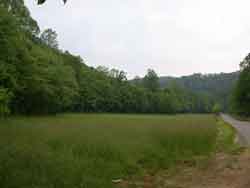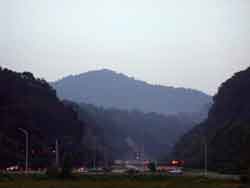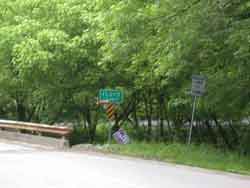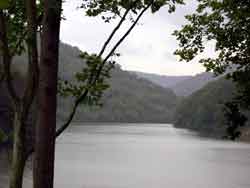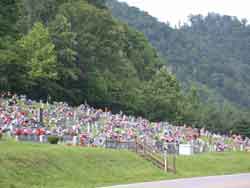JOHN MONROE PRIEST AND MAHALA JANE JAMES
The area right outside of Pikesville is in the heart of Appalachia, and the Priest’s neighbors were the James’, McCoy’s, Dean’s, Hatfield’s and Stratton’s to name a few. On February 27, 1848 John married his neighbor Mahala James, the second youngest daughter of Samuel James’ sixteen children. To learn more about theJames Family go to their pages.
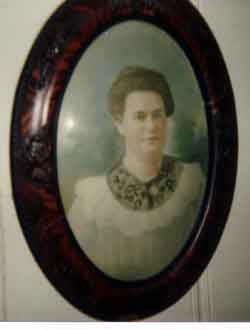 To the left is a picture of Mahala as a young woman that my cousin Garnet Crider Ewing’s granddaughter has hanging on her wall. I am very jealous. Garnet says the picture was her grandmother Minerva’s and always hung in their home. Mahala’s father died when she was seven and she and her siblings lived with their Mother Pernina Dean James. Pernina is quite a woman in her own right. To learn more about the Deans visit theirFamily Page.
To the left is a picture of Mahala as a young woman that my cousin Garnet Crider Ewing’s granddaughter has hanging on her wall. I am very jealous. Garnet says the picture was her grandmother Minerva’s and always hung in their home. Mahala’s father died when she was seven and she and her siblings lived with their Mother Pernina Dean James. Pernina is quite a woman in her own right. To learn more about the Deans visit theirFamily Page.
Apparently Pernina and her father came by themselves from North Carolina to Johns Creek, Kentucky and built a cabin. They journeyed by horseback, father and daughter, through the wilderness in 1808, a year before the James and Charles families arrived. Pernina was 14 years old. It took time to build a cabin and both labored hurriedly, for the father wanted to bring the rest of the family from North Carolina before winter came along.
He and Pernina talked of the return trip and the decision was made for her to stay at the cabin until he returned. To construct a safe sleeping place, a frame-work was swung to the cabin rafters and food to last for his absence was stored in the swinging haven. At night she climbed in and slept, food lying beside her, safe from prowling animals. She told her descendants, over and over again the story of the terrible nights alone in the swinging bed, of how the wild beasts would scream and she would cry from loneliness and fear until her parent returned. She married Samuel James when she was sixteen. He was 31, widowed and already had six children. He and Pernina had ten more children. Mahala’s Father died when she was seven, so she really didn’t know Samuel very well.
When Mahala was sixteen Abner James her half-brother from Samuel’s first marriage to Sarah Charles was named her guardian. In 1847 William McCoy who was deputy sheriff of Floyd County had put together a “posse” including his brother-in-law Abner James and neighbor John Priest to arrest William Prewett on a peace warrant. During the arrest Abner shot Prewett and was tried and convicted of murder. John Priest testified at the trial. Governor William Owsley pardoned Abner eleven days before he was to hang January 21, 1848. To read a transcript of the trial including a copy the guilty verdict and gubernatorial pardon please go to Documents under the James Family page. John Priest married Mahala James with Abner’s consent a month later. It is interesting that their marriage certificate lists Abner James as her Father and in the 1880 census she lists her Father as having come from North Carolina where Abner was born. It is clear she thought of Abner as her Father. Samuel was born in Massachusetts. According to the census records the Priest’s lived next to the James.
John and Mahala Priest had 10 children: Susannah (Susan), Mary Jane, Minerva Elizabeth, George Washington, John Monroe Elliott (Elliott), Robert Hughey, Monteville, William Marian (Marian), Nancy Catherine, and U.S. Grant. The first seven children were born before the Civil War. As with many families the Civil War was a defining moment for the Priest family. We know from Mahala’s Civil War Widow’s pension application that John sought out Captain Martin Thornsbury’s Company, D of the Union Army’s 39th Kentucky Regiment of United States Infantry Vols in Pike County Ky on the Sixteenth day of November 1862, to serve 3 years; The 39th Kentucky Regiment has a wonderful web site. John’s brother-in-law Abner James and his son William were in Company C along with William Priest (who is related to John but I’m not quite sure how yet). There were many of John’s extended family in the 39th.
John almost immediately contracted adult measles and spent a year in the U.S. General Hospital in Ashland, Kentucky when he received a medical disability discharge for (sic) para plegia and deformity of the spinal column caused by rheumatic palsy for ten months which rendered him unfit for the invalid corps. From the affidavit by the Doctor James M Montmollin.
“That during fall or summer of 1863 said John Priest first came under his notice by being brought to the Hospital with a severe attack of measles which by exposure in camp which resulted in a severe case of Pneumonia. Said Priest never rallied but was a constant invalid during the time he remained in Hospital. He lost his voice. His kidneys became diseased and he was a doomed man from the time he came there one year after his attack. He constantly complained of tasting the measles in his throat. He was so much disabled that we both (my assistant Dr. Weis now of Peoria, Il. and myself) pronounced him incurable and made application for his discharge. Weis knows nothing from Priest since discharge but is unqualified in the belief that consumption & kidney disease had secured upon him such a hold that he never could have recovered from either of them. He was so lame for was compelled at times to use crutches for his movement. He was as white as chalk – the kidneys having drained all the albumen from his blood. When he tried to do the little chores in the kitchen such as wiping dishes or peeling potatoes it was the utmost he could accomplish. He was one of the most patient men and (sic) actable patients we ever had in the hospital. He was never known to violate a rule or to complain of anything during the long time he was under me which must have been nearly a year if not more than it.”
Based on the information in Mahala’s Widow’s Pension Application John was an invalid the remainder of his life and the family faltered. In some ways we are very lucky, although it is very sad. After John died in 1889 Mahala tried to get a widow’s pension. In the write up by the Special Examiner from the Government, he writes “I learned upon inquiry that the relatives of the deceased soldier believed that he had an application upon file for pension which they believed was filed about 1867. The neighbors of the soldier state that he was a man that was averse to the annoyance of getting up the papers. He appears to have died almost in want if the signs around the old homestead count for anything. He was undoubtedly an invalid from the time he was discharged from the service. The claim is beyond doubt one of merit, but as the widow has died since filing her claim and there being no minor heirs, the claim will have to be awarded to the children that are living of which there are said to be ten [In the margin is a handwritten “Hardly!”]
William Collingsworth affidavit is typical of those describing John’s condition.
“That his occupation is farmer and the claimant’s is a farmer and that he became acquainted with said claimant in the year 1857 or thereabout, and that his acquaintance with him has been continuous from that time up to his death and that he has lived within two miles of him and that he has seen him once every two weeks on an average, during the above period.
At the time when he returned home from the army I saw him on crutches and his disabilities were rheumatism. In the month of I do not know year of 1863 or 1864 claimant was suffering from rheumatism and was affected as follows by said disabilities: by lameness in back & hips. Soldier had some kind of lung trouble I know not what he had a very bad cough until he died for many years. I heard him say since discharged that he had (sic) catarrts in the head which was caused by measles & destroyed his smell.
That he has continued to suffer from said disabilities in the manner described from the time stated up to the time of his death and during each and every year of the above period claimant has been disabled by reason of said disabilities to the extent of at least three fourths of him time from work for the performance of manual labor by reason of above stated disabilities, and in consequence thereof has lost about eighteen years of his time.
That his means of knowing the facts above testified to are as follows: I worked with him and he has been at my house often & I have been at his house I heard him complain f his rheumatism.”
Somewhere along the way Mahala started receiving a pension of $8 a month. I think they also wanted either back benefits, benefits for the children, or an increase to $12 a month. On July 6, 1989 after ten years and two special examinations the examiner recommended that her application had merit. She died two days earlier on July 4th. Because of the investigations there is a thick file of affidavits and other information available to us on John and Mahala and the family that we would never have known. The Priest’s were very secretive.
Somewhere around 1883 John Monroe Elliot “Elliot” moved to Carrol County, Arkansas. Monterville followed around 1885. We don’t know the circumstances for the move. Eventually the six youngest children ended up in this area. Carroll County is just across the Missouri – Arkansas County line and is just south of Golden, Barry County, Missouri. Based on Mahala’s widow’s pension application there were quite a few Floyd County, Kentucky friends who lived in this area. According to historical records it was not uncommon for someone to move, tell their former neighbors about the new opportunities, and then have friends come. With large families and unproductive farms in Appalachia younger children moved on for new opportunities. Here I think the Priest family move was compounded by John’s failing health (although he was able to have three more children after the war!). After John died in August 1889 Mahala also decided not to stay in Floyd County and instead moved to the Golden, Missouri area to live with Grant her youngest son and to be close to her other children. Minerva and George were the only children to stay in Floyd-Pike Counties. The pictures below are the area in Floyd County where the Priest’s lived. It is beautiful county and I feel a great connection when I am there.
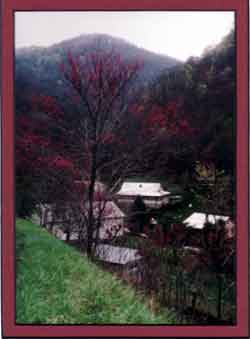 ::__IHACKLOG_REMOTE_IMAGE_AUTODOWN_BLOCK__::2
::__IHACKLOG_REMOTE_IMAGE_AUTODOWN_BLOCK__::2 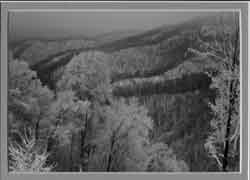
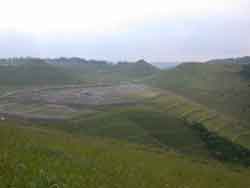
The last picture is of a mountain top leveled by mining. They are doing this on the hill behind where the James and Priest’s lived on Brushy Creek. It is so sad to see the tops of these majastic hills leveled.
